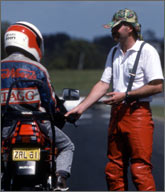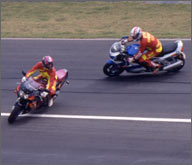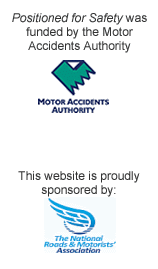Rider Training in NSW
 Learner training
Learner training
The NSW rider Graduated Licensing Scheme (GLS) involves two compulsory rider training courses (see chart on right). The first, a 2 day learn-to-ride course must be completed to obtain a Learner Rider Licence. The second course includes an on-road ride and riding test to obtain a Provisional Rider Licence. The program is available in most areas of the State.
Riders on Learner and Provisional licences are subject to a number of restrictions. These include blood alcohol concentration (BAC) of zero and riding LAMS (Learner Approved Motorcycles Scheme). LAMS are motorcycles or scooters which have a power to weight ratio not greater than 150 kilowatts per tonne and an engine capacity not greater than 660ml. Riders on Learner and and Provisional (P1) licences are not permitted to carry a pillion passenger.
Compulsory rider training in NSW was first introduced in 1990 and has evolved with the GLS since then. Over the first 10 years, there was a drop of 27% in riders killed and injured in crashes. The greatest benefit was amongst young riders (aged under 26) with a 57% drop in casualties from 1664 in 1990 to 743 in 2000.
Despite the significant reduction in crashes, the picture of what is actually happening is not clear. While the number of young riders (under 26) who crashes is down, they are still much more likely to crash than older riders. In 2008, young riders were only 8% of the registered motorcycle owners in NSW but had 27% of the crashes.
It may be that, at least a part of, the effect of compulsory training has been to discourage impulsive decisions to get a licence. More work is urgently needed to investigate the best approach to rider training and licensing.
Age exemption
Anyone over age 25 who holds a current Australian unrestricted drivers licence and has completed a minimum of 12 months on their Provisional (P1) riders' licence may be exempted from the P2 phase and proceed directly to an unrestricted riders licence. There are no age exemptions for the training courses if they are available in their area.
Post licensing training
Once a rider has completed their learner training and pre-provisional training, any further development of their skills or attitudes towards riding is at their own initiative and expense. Many riders do undertake further training, but there is no independent source of support or advice on appropriate post license training courses.

Many road safety experts have serious reservations about the value of advanced rider training based on findings relating to advanced car driver training programs. Research suggests that safe car driving is more about attitude than operational skill, and advanced driver skills development may create unrealistic optimism and actually encourage risk taking behaviour.
It is evident that safe riding requires a much higher component of skill and judgment (for example in cornering or handling a loss of traction) than does safe driving. However there has been little comparable research into the benefits of advanced rider training. Haworth et al (1997) did find some evidence that a significant decrease in the odds of crashing was associated with having completed an advanced rider training course. They also found that ineffective braking, or a failure to respond to a threat, occurred in 20% and 17% respectively, of the motorcycle crashes that they examined in Victoria.
There are essentially three means by which licensed riders can improve their riding skills. These are formal advanced rider training programs and less formal day rides and track days.
 Advanced rider training
Advanced rider training
Advanced rider training courses are offered by a number of rider training providers. They provide assistance in refining critical skills once the rider has achieved sufficient experience to understand and apply the new learning. They generally focus on roadcraft, cornering, braking skills etc, all of which are immediately transferable to riding on public roads.
Day rides
Day rides are organized trips by groups of motorcyclists. They are primarily social but may also be designed to provide advice and support, or just company, for inexperienced riders on longer trips. Experienced riders are often paired with novices on day rides.
Track days
Track days are conducted at off road tracks but they are not races. They may be regarded as an opportunity to ride at speed or/ and to develop and refine crucial riding skills. They can be an opportunity to learn to handle a motorcycle at touring speeds with skill and precision in a safe environment.
Motorcycling is a far more physical experience than driving a car and correct sequence and timing of body movements can make the difference between control and a crash, particularly over slippery surfaces. It is far safer to learn and practice these movements upon a track where run-off zones and an absence of roadside furniture minimize the risks arising from an error of judgment.
Professional track day operators provide instructors to assist riders in developing the skills and in diagnosing and correcting specific skill deficiencies. Activities may include refining the skills of placing a motorcycle correctly for cornering, so as to avoid leaning across the centre line, or to learn how to make mid-corner corrections of speed and path of travel. Other useful skills include learning to become comfortable with the movement of a motorcycle over a broken or slippery surface and learning how to recognise situations in which a mis-judgement is likely to be made.

